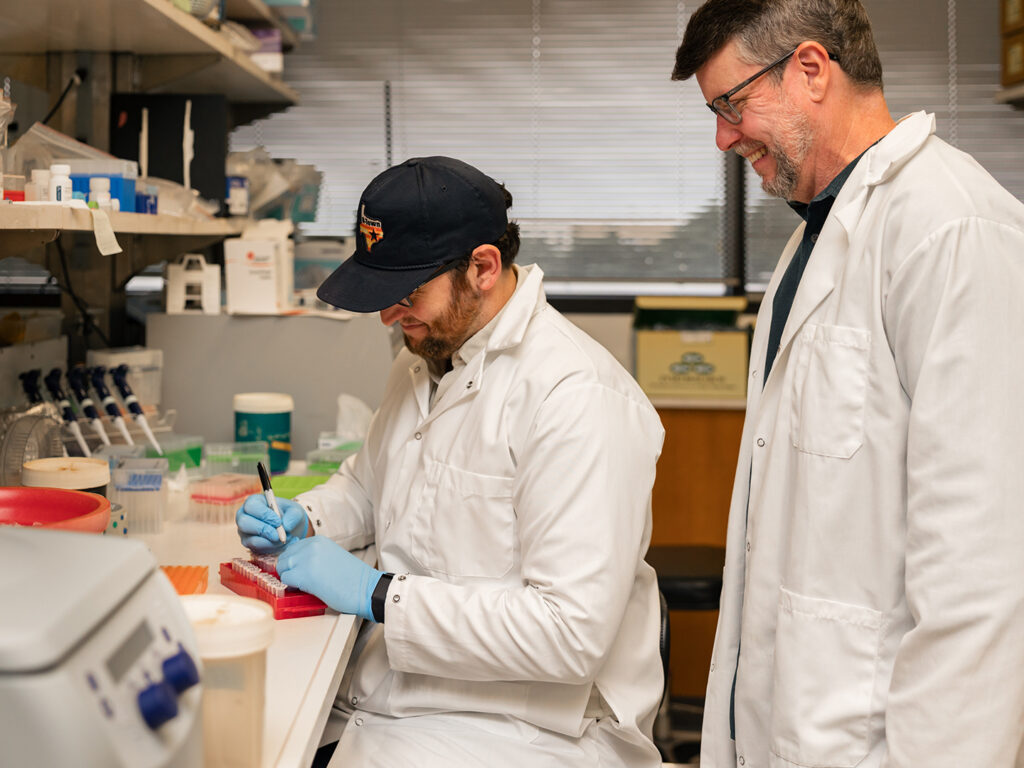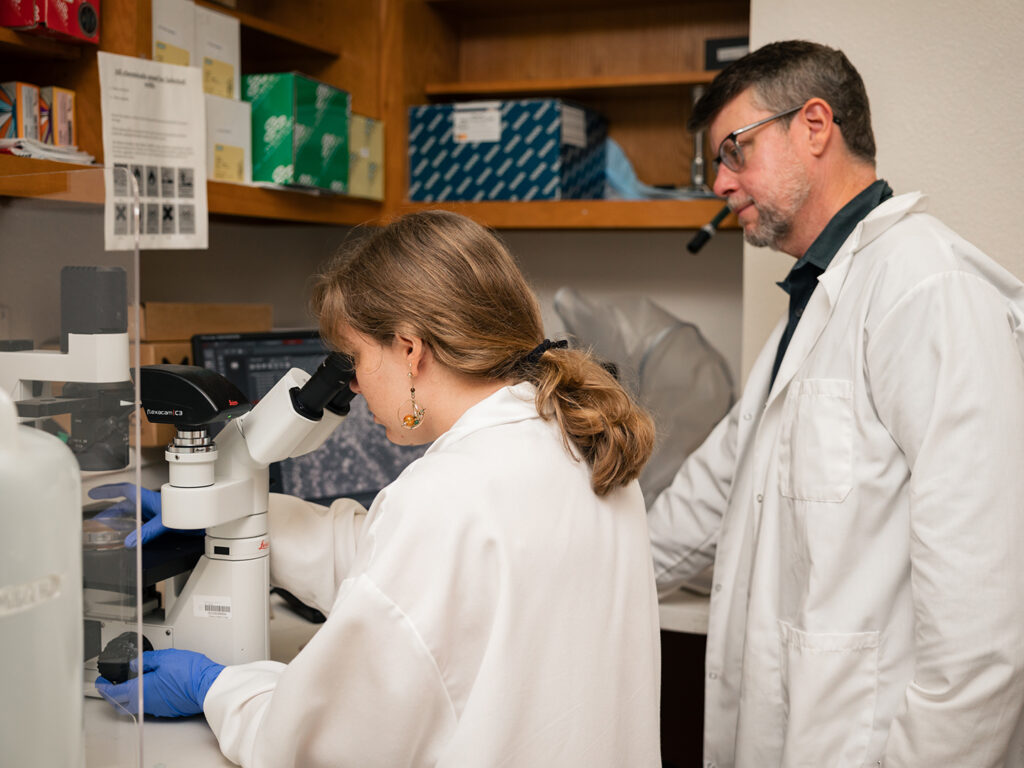Texas A&M Researchers Receive NIH Grant To Improve Quality Of Life For People With Down Syndrome
Story by Courtney Price, VMBS Communications

Photo by Jason Nitsch ’14, Texas A&M University Division of Marketing and Communications
A team of researchers at the Texas A&M University School of Veterinary Medicine & Biomedical Sciences (VMBS) has received a grant from the National Institutes of Health (NIH) to research metabolism in people with Down syndrome.
By targeting genes that affect metabolism, the team may be able to develop drug therapies for physical and mental symptoms of the condition, like muscle loss, accelerated aging, and lower cognitive function, thereby improving the quality of life for people with Down syndrome.
The new grant will also make Dr. Weston Porter, a professor in the VMBS’ Department of Veterinary Physiology & Pharmacology and lead researcher on the project, one of the highest NIH-funded researchers at Texas A&M.
Making Connections
Down syndrome is a genetic condition that affects approximately 1 in every 700 fetuses and can cause varying degrees of physical, mental, and developmental disability. There are currently about 400,000 people with Down syndrome living in the United States.
Porter’s interest in studying Down syndrome came by way of breast cancer research, which he’s been conducting for over 20 years.
“Part of our lab team works on a protein called SIM2 and its relationship to breast cancer,” Porter said. “SIM2 happens to be in the middle of a section of chromosome 21 that we call the ‘Down syndrome-critical region.’ Almost every individual with Down syndrome has an extra copy of this gene.”
Genetic conditions like Down syndrome are closely linked with changes in tumor and cancer profiles, like breast cancer, according to Porter.
“Primarily, we see an increase in tumor incidents in individuals with genetic diseases. For example, people with Down syndrome are more likely to develop leukemias and lymphomas. However, breast cancer is extremely rare for these individuals,” he said.
Porter and his team of researchers have previously been awarded grants to study the intersection of breast cancer and Down syndrome. The team studied the role of SIM2 in providing people with Down syndrome increased resistance to breast cancer because of Down syndrome’s triplication of certain genes.
“Having SIM2 offers a sort of protective mechanism against breast cancer, but the over-expression of SIM2 leads to the development of other health concerns,” said Lilia Sanchez, a graduate student in Porter’s lab. “Our goal is to better understand the role SIM2 plays and also how much is too much so that we can develop therapies that help combat diseases related to both the over- and under-expression of SIM2.”
The lab’s research into the connection between breast cancer and SIM2 led them to believe that the protein might also be involved in regulating crucial metabolic factors in Down syndrome.
“Many of the phenotypic elements of Down syndrome — the physical and mental manifestations like muscle loss, increased chance of Alzheimer’s and Parkinson’s diseases, developmental disability — are linked to changes in metabolism,” Porter said. “The reason for this is that the cells’ mitochondria, which help regulate metabolism, are constantly running at full steam in Down syndrome. It’s like running the car engine all the time.”
Likewise, the changes in metabolism that people with Down syndrome experience come from having an overexpression of SIM2.
“When SIM2 is overexpressed, we see that it ramps up the mitochondria — you’re turning it on, but you cannot turn it back off,” he said. “That results in mitochondrial dysfunction.”
Multi-faceted Mitochondria

Photo by Jason Nitsch ’14, Texas A&M University Division of Marketing and Communications
Contrary to what most people remember from high school, mitochondria aren’t just powerhouses for cells. They play a role in a number of cellular processes, which is one reason that metabolism is so interconnected with Down syndrome.
Sanchez has published research describing how SIM2 regulates mitochondria during periods of stress. Her research examined SIM2’s role in regulating mitochondrial health in breast tissues during lactation, which is a stressful time for mammary cells.
“The main takeaway from this paper is that mitophagy, which is the recycling of mitochondria, is a normal process that naturally happens in tissues that are highly active,” Sanchez said. “Mitophagy is also involved in the stress response of the cell, and our data suggest that SIM2 regulates the rapid recycling of mitochondria, thus enhancing functions accompanied by higher stress, such as lactation.”
SIM2 also impacts mitochondria in other ways, according to Dr. Steven Wall, a former graduate student in Porter’s lab.
“SIM2’s role in electron transport is the most novel thing we found,” said Wall, who served as the lead author for another publication produced by the lab. “Previously, it was not known to be involved in the electron transport chain, yet we found it consistently in the mitochondria and in the electron transport chain.”
Since the electron transport chain is a fundamental part of how the mitochondria regulates energy, it’s clear that SIM2 has the ability to regulate some of the most important functions within our cells.
Combined with SIM2’s rapid recycling effect on mitochondria, it also appears to be crucial for understanding Down syndrome.
Transforming Life With Down Syndrome
While the new grant will specifically look at SIM2’s role in regulating skeletal muscle metabolism, Porter also hopes that the project will lead to studies of other parts of the body and will eventually make new therapies available to people with Down syndrome.
“Given the amount of research happening on genetic diseases right now, it’s becoming much more possible to develop drugs for those diseases,” he said. “Working with Down syndrome is tricky because there are 20 to 30 genes changing, but, incrementally, we hope to improve people’s quality of life.”
Porter and his team are also developing ways to involve the Down syndrome community in offering feedback and ideas for future research directions.
“We want to know their concerns so that we can prioritize research that addresses them,” he said. “They can help us decide which aspects of life with Down syndrome to focus on next in our research — things like improved mobility, cognitive function, or life expectancy.”
Ultimately, Porter believes the new study will have a big impact for people with Down syndrome.
“It’s going to be transformative,” Porter said.
###
For more information about the Texas A&M School of Veterinary Medicine & Biomedical Sciences, please visit our website at vetmed.tamu.edu or join us on Facebook, Instagram, and Twitter.
Contact Information: Jennifer Gauntt, Director of VMBS Communications, Texas A&M School of Veterinary Medicine & Biomedical Sciences, jgauntt@cvm.tamu.edu, 979-862-4216


